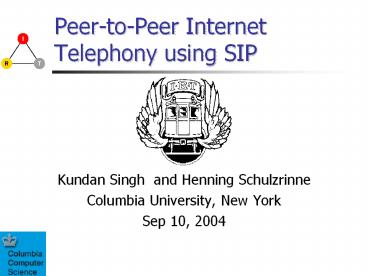Peer-to-Peer Internet Telephony using SIP - PowerPoint PPT Presentation
1 / 18
Title:
Peer-to-Peer Internet Telephony using SIP
Description:
Discover peers: multicast REGISTER. Join DHT using node-key=Hash(ip) ... Attached nodes detect and re-REGISTER. New REGISTER goes to new super-nodes ... – PowerPoint PPT presentation
Number of Views:35
Avg rating:3.0/5.0
Title: Peer-to-Peer Internet Telephony using SIP
1
Peer-to-Peer Internet Telephony using SIP
- Kundan Singh and Henning Schulzrinne
- Columbia University, New York
- Sep 10, 2004
2
Agenda
- Introduction
- Client-server vs P2P for VoIP
- Related work Skype
- P2P-SIP architecture
- Design alternatives
- DHT (Chord) and SIP
- Node startup, peer discovery, node failure
- Advanced services
- Offline messages
- Conferencing
- Conclusions and future work
Total 18 slides
3
SIP Session Initiation Protocol
REGISTER alice_at_columbia.edu gt128.59.19.194
INVITE alice_at_columbia.edu
Contact 128.59.19.194
Alices host 128.59.19.194
Bobs host
columbia.edu
Client-servergt maintenance, configuration,
controlled infrastructure
4
P2P Advantages
- Resource aggregation - CPU, disk,
- Cost sharing/reduction
- Improved scalability/reliability
- Interoperability - heterogeneous peers
- Increased autonomy at the network edge
- Anonymity/privacy
- Dynamic (join, leave), self organizing
- Ad hoc communication and collaboration
5
Related work Skype From the KaZaA community
- Host cache of some super nodes
- Bootstrap IP addresses
- Auto-detect NAT/firewall settings
- STUN and TURN
- Protocol among super nodes ??
- Allows searching a user (e.g., kun)
- History of known buddies
- All communication is encrypted
- Promote to super node
- Based on availability, capacity
- Conferencing
6
We propose P2P-SIP
- Unlike server-based SIP architecture
- Unlike proprietary Skype architecture
- Robust and efficient lookup using DHT
- Interoperability
- DHT algorithm uses SIP communication
- Hybrid architecture
- Lookup in SIPP2P
- Unlike file-sharing applications
- Data storage, caching, delay, reliability
- Disadvantages
- Lookup delay and security
7
Background DHT (Chord)
Key node
81 9 14
82 10 14
84 12 14
88 16 21
81624 32
83240 42
1
54
8
58
10
14
47
21
- Identifier circle
- Keys assigned to successor
- Evenly distributed keys and nodes
- Finger table logN
- ith finger points to first node that succeeds n
by at least 2i-1 - Stabilization for join/leave
42
38
32
38
24
30
8
Design Alternatives
servers
1
54
10
38
24
30
clients
Use DHT in server farm
Use DHT for all clients But some are resource
limited
- Use DHT among super-nodes
- Hierarchy
- Dynamically adapt
9
Architecture
Signup, Find buddies
IM, call
On reset
Signout, transfer
On startup
Leave
Find
Join
REG, INVITE, MESSAGE
Multicast REG
Peer found/ Detect NAT
REG
- DHT communication using SIP REGISTER
- Known node sip15_at_192.2.1.3
- Unknown node sip17_at_sippeer.net
- User sipalice_at_example.com
10
Node Startup
columbia.edu
- SIP
- REGISTER with SIP registrar
- DHT
- Discover peers multicast REGISTER
- Join DHT using node-keyHash(ip)
- REGISTER with DHT using user-keyHash(alice_at_columb
ia.edu)
REGISTER
alice_at_columbia.edu
Detect peers
REGISTER alice42
58
42
12
14
REGISTER bob12
32
11
Super-nodes
- Initial bootstrap super-nodes
- Never allow capacity to exceed
- When to become super-node
- Local decision can be influenced by existing
peer - If REGISTER received
- Local key gt store locally
- Else, forward REGISTER to appropriate nodes
- Super-node refreshes REGISTER on behalf
- Should be in public address space (?)
REGISTER key42
REGISTER
DHT
42
12
Node Leaves
- Graceful leave
- Un-REGISTER
- Transfer registrations
- Failure
- Attached nodes detect and re-REGISTER
- New REGISTER goes to new super-nodes
- Super-nodes adjust DHT accordingly
REGISTER key42
REGISTER
OPTIONS
DHT
42
42
13
Dialing Out
- Call, instant message, etc.
- INVITE siphgs10_at_columbia.edu
- MESSAGE sipalice_at_yahoo.com
- If existing buddy, use cache first
- If not found
- SIP-based lookup (DNS NAPTR, SRV,)
- P2P lookup
- Send to super-nodes proxy
- Use DHT to locate proxy or redirect to next hop
INVITE key42
Last seen
302
INVITE
DHT
42
14
Offline messages
- INVITE or MESSAGE fails
- Responsible node stores voicemail, instant
message. - Delivered using MWI or when online detected
- Replicate the message at redundant nodes
- Sequence number prevents duplicates
- Security How to avoid spies?
- How to recover if all responsible nodes leave?
15
Conferencing (further study)
- One member becomes mixer
- Centralized conferencing
- What if mixer leaves?
- Fully distributed
- Many to many signaling and media
- Application level multicast
- Small number of senders
16
Explosive growth (further study)
- Cache replacement at super-nodes
- Last seen many days ago
- Cap on local disk usage (automatic)
- Forcing a node to become super node
- Graceful denial of service if overloaded
- Switching between flooding, CAN, Chord,
- . . .
17
More open issues (further study)
- Security
- Anonymity, encryption,
- Attack/DOS-resistant, SPAM-resistant
- Malicious node
- Protecting voicemails from storage nodes
- Optimization
- Locality, proximity
- Motivation
- Why should I run as super-node?
18
Conclusions
- P2P useful for VoIP
- Scalable, reliable
- No configuration
- Not as fast as client/server
- P2P-SIP
- Basic operations easy
- Implementation
- sippeer C, Linux
- Interoperates
- Some potential issues
- Security
- Performance































